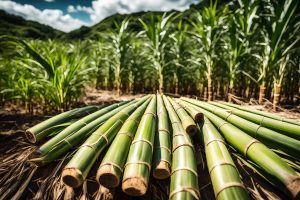
Economics/Biometry & IT
Sustainable increase of productivity and profitability of the sugar industry by improving its economic aspects, and efficiency of sugarcane research.
-------Quick Menu-------
The Economic and Biometry Division is a cornerstone of the sugar industry, dedicated to enhancing productivity and profitability through meticulous research and analysis. With over thirty years of experience, this division focuses on improving the economic aspects and efficiency of sugarcane research, ensuring sustainable growth and resilience.
Economics: This branch of the division conducts comprehensive economic assessments of new technologies, evaluates the productivity and profitability of sugarcane cultivation, and develops policy guidelines to foster the industry’s development. By examining the financial viability of various sugarcane-related products and processes, the economics team provides valuable insights to optimize cultivation and processing strategies.
Biometry: This branch specializes in assessing the adaptability of new sugarcane varieties and analyzing climatic changes affecting sugarcane-growing regions. By determining sampling methods, analyzing rainfall patterns, and identifying climatic trends, the biometry team ensures that sugarcane varieties are well-suited to their environments, ultimately enhancing crop performance and sustainability.
Through their combined efforts, the Economic and Biometry Division plays a pivotal role in driving the success and advancement of the sugar industry in Sri Lanka.
Priority Areas
Economics

Economic and Policy assessment

Productivity and Profitability
- Economic assessment of new technologies developed by the institute
- Assessment of productivity and profitability of sugarcane cultivation and processing of sugarcane and its co-products
- Economic assessment of policies related to sugar industry and provision of policy guidelines for the development of the sugar industry
Biometry

Adaptability sugarcane varieties

Analysis Climatic changes
- Assessment of adaptability of new of sugarcane varieties
- Analysis of climatic changes of sugarcane-growing areas in Sri Lanka
Ongoing Research Activities..
Site-specific fertilizer management requires optimizing nutrient inputs by considering both temporal and spatial variability of the sugarcane field. Variability mapping and crop reflectance sensor-based techniques are prominent for implementing site-specific management of crop inputs. But traditional soil and plant sampling methods are not economical when considering the level of accuracy needed in larger sugarcane cultivation areas where the level of spatial nitrogen variability can exist over short distances in fields. The sensors used to identify and collect spectral and spatial information, equipped to satellite or airborne vehicles and their uses depend on the scale of the level of expected details. Satellite images have been used to derive spectral and spatial information, yet in the case of high-level detail scales monitoring, the use of Unmanned Aerial Vehicles (UAVs) is becoming great equipment for this task. Multiple vegetation indices derived from the visible and infrared spectrum of conventional, multispectral and hyper-spectral sensors have been created to assess different agronomic parameters such as leaf area index (LAI). Chlorophyll content, sugarcane crop biomass and leaf nitrogen concentration throughout the world.
Therefore, sensor based methods by light reflectance measurements have been used for sugarcane cultivation to estimate the real time crop status of the plants. Multispectral drones, real time soil status measurement technologies, digital mapping opens up new pathways to monitor and support decision making processes in a more precise way. With that intention this research project will design and carry out the following objectives.
Objectives and targets
- To evaluate the potential of delineating site-specific management zones using precision agriculture techniques for sugarcane cultivation
- To develop site-specific nutrient management zones using precision agriculture techniques for sugarcane cultivation
- To evaluate the effectiveness of nutrient management zones for sugarcane cultivating areas in Sri Lanka
Contact Mr. U.W.L.M. Kumarasiri for more details
In Brazil it has been found sugarcane plants respond positively to fertilization with filter-mud which has raised the accumulation of P, K and Cu in aerial parts of the plants. The Crop Nutrition Division of the Sugarcane Research Institute has developed a compost using industry by-products i.e. filter mud and vinasse of the Sugar and Ethanol Industry. On average 200-300 Litres of vinasse can be applied for a 1 ton of filter-mud to maintain the optimum moisture level of the heap which is important for the composting process. As per the conditions of the heap, vinasse can be applied again in, timely intervals without disturbing the process and quality of the end compost product.
The prepared compost will be used as the baseline to initiate organic compost/fertilizer research by the Crop Nutrition Division which will be carried out to expose the actual situation of organic cultivation compared with application of inorganic fertilizer.
Objectives and targets
- To investigate the performance of cane and sugar parameters of sugarcane with the usage of different quantities of the prepared organic compost mixture.
- To investigate the possibility of reducing the amount and cost of organic compost mixture for sugarcane cultivation without an economic loss.
There are different products of organic compost and organic fertilizers available in the market to be used in crop cultivation. Suitable products should be identified for sugarcane cultivation where those should be tested at laboratory and field level. In addition organic related material that enhances the soil could be developed and one such is biochar which could be used to improve the soil. Biochar is a carbon rich substance and it is produced during the thermal decomposition of organic wastes under a limited supply of oxygen and at relatively low temperatures (<7000C). Biochar is characterized by its high content of organic carbon and the low susceptibility to degradation. When compare to the biomass materials, biochar has a higher surface area and porosity, catalytic activity and physicochemical activity. Biochar has applications in the areas of soil improvement, mitigation of climate change, energy production and waste management. Biochar improves soil physical and chemical properties. Raising soil pH, increasing water holding capacity, increasing cation exchange capacity and nutrient retention are few soil benefits from the biochar. Also biochar creates an environment with higher aeration which causes to improve the soil microbial activity and thereby helps to improve plant growth and crop yield. For selectively improve the physicochemical properties of soil, different types of biochars can be produced by selecting specific biomass and production conditions.
The characteristics of biochar vary depending on the type of biomass and the production conditions like treatment temperature, heating rate and holding time. Various types of biomass like coconut husk, coconut shell, rice husk, rice straw, sugarcane bagasse, sugarcane waste straw, palm shell, corn straw, wheat straw and coffee husk have explored for the potential to produce biochar through pyrolysis. For efficient and economical production of biochar the availability and the composition of biomass is very important. The cellulose, hemicellulose, lignin, fixed carbon content and volatile matter content of the biomass is significantly affecting for the biochar properties and its morphology. The biochar production could be carried out by two methods namely, traditional and using modern techniques. As the traditional approaches there are ancient methods and conventional pyrolysis techniques like slow pyrolysis and fast pyrolysis. Gasification, hydrothermal carbonization, electro modification and modified traditional methods like flash pyrolysis, vacuum pyrolysis and microwave pyrolysis are modern approaches.
Objectives and targets
- To identify commercially available organic amendments suitable for sugarcane cultivation in Sri Lanka
- To compare the characteristics of various sugarcane biomass; bagasse, sugarcane waste from mini mill and sugarcane trash derived biochars from laboratory and barrel techniques.
- To determine the effect of biochar on improvement of soil fertility of long-term sugarcane growing soils.
- To identify the best amounts of boiler-ash as a soil amendment enhance its use effectiveness.
At present, about 2000-3000 cane samples, leaf samples and soil samples are analyzed annually at the crop nutrition laboratory. Most of the samples come from the experiments conducted by other divisions of SRI. Providing required analytical facilities is one of the prime objectives of SRI.
Objectives and targets
To analyze the samples of other divisions at SRI and improve the laboratory methods according to acceptable standards and for the requirements of sugar companies.
Our Staff..

Mr. Buddhika R. Kulasekara
Research Officer In-charge
MSc, University of Peradeniya
B.Sc, University of Sabaragamuwa
Research Interest:
- Soil Science
- Sugarcane Nutrition
- kulasekara@sugarres.lk
- kulasekaraya@gmail.com
- ResearchGate
- ORCiD
- Google Scholar

Mr. U.W.L.M. Kumarasiri
Research Officer
MSc, University of Peradeniya
B.Sc, Eastern University Sri Lanka
Research Interest:
- Soil Science
- Remote and proximal Sensing
- Machine Learning
- Expert System Development
- Kumarasiri99@sugarres.lk
- lahirumadhushankaln99@gmail.com
- ResearchGate
- ORCiD
- Google Scholar

Mr. G.S. Udawatta
Senior Technical Officer
Job Role: Assisting research staff for research
